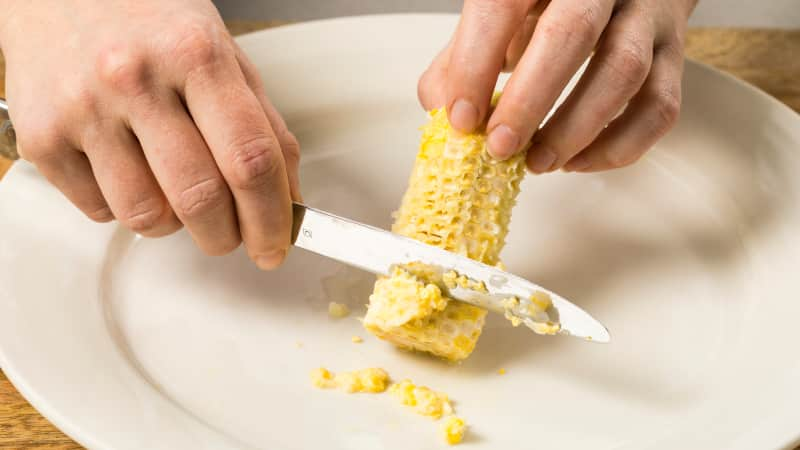The United States produces three times as much corn as any other nation. Along with wheat and rice, corn is one of the world’s staple grains. But did you know there are two main types? We eat sweet corn like a vegetable, but field corn requires processing. Here’s everything you’ll need and want to know about corn to take advantage of it this summer.
Getting to Know The Two Main Types of Corn
Published July 24, 2018.

Sweet Corn
It used to be that you had to eat corn within a few days of picking for it to taste sweet. That's because the sugars in corn start converting to starch as soon as the ear is picked. But most corn you buy today has been bred to hold on to its sweetness longer. Here’s how to shop for, shuck, cook, and get the most flavor out of sweet corn.
Shopping for Corn: Look for firm, plump ears that feel heavy for their size. The husk should be a deep green, and the silk should be dry.
Shucking Corn: As you probably know, removing the husk and silk from an ear of corn can be a chore, but we’ve found a way to make it easier for you. A short stint in the microwave and a quick shake are all it takes to cleanly slide off the corn’s husk and silk. The cob will heat up a bit, but the kernels won’t be cooked. (Read more about shucking corn in our “Easiest-Ever Way to Shuck Corn” article.)
Cooking Corn: For foolproof cooking, bring water to a boil, add salt to season, drop in the shucked corn, cover, turn off the heat, and let the corn sit until just crisp-tender, 10 to 15 minutes.
Finding Cobs' Hidden Flavors: First, to cut the kernels off the cob shuck the corn, slice cobs in half crosswise, stand up the halves, and cut down the sides to remove kernels. Then, run the back of your knife down the stripped cobs to release the flavorful “corn milk.” (After they're milked, you can simmer stripped cobs in water to make flavorful corn stock that you can use when making corn chowder.)


TAKEAWAY: Stripped cobs are a treasure, not trash.
Sign up for the Cook's Country Dinner Tonight newsletter
10 ingredients. 45 minutes. Quick, easy, and fresh weeknight recipes.
Field Corn
Field corn is a high-starch, low-sugar corn used for making cornmeal and myriad culinary and industrial products; it's also used for animal feed. When heated with an alkaline solution, it becomes “nixtamalized” and is the basis for hominy, masa harina, and corn tortillas. Unless you're a farmer, chances of you coming across field corn is unlikely. Below are a few of the other common food products containing field corn.
Cornmeal, Grits, and Polenta: These products are all dried field corn ground to different sizes. We prefer a medium grind of cornmeal for making prepared polenta (Italian-style cornmeal porridge) and finely ground cornmeal for most baked goods. Grits have the coarsest grind and should not be substituted for cornmeal in most recipes.
Cornstarch: When using this thickener, first mix it with a small amount of liquid to create a slurry, and then mix it into the dish you wish to thicken. We also use cornstarch to coat small pieces of meat for stir-fries; this process, called velveting, creates a silky texture on the outside of the meat.
Corn Syrup: Is made from cornstarch. It's about half as sweet as sugar, is very thick, and doesn't crystallize. We use it in glazes, cakes, pies, and other sweet baked goods. Note that corn syrup is not the same as much-sweeter high-fructose corn syrup, which undergoes additional processing and is used in the production of soda, candy, and other processed foods.
Bourbon: This southern spirit is made with a variety of grains, but the mix must contain at least half corn. Bourbon is a robust whisky, but it has a subtle sweetness we use in many of our test kitchen recipes like Grilled Bourbon Steaks, New Orleans Bourbon Bread Pudding, and Smoked Bourbon Chicken.
Popcorn: Not all corn will pop when dried. The popcorn we enjoy is grown from a special variety of corn that retains just enough moisture when carefully dried; when the corn is heated, the moisture turns to steam that ruptures—or pops—the hull. We love popping our own, but when convenience calls, our favorite bagged popcorn is Smartfood Delight Sea Salt Popcorn.
Other Products: Plastics, cosmetics, breakfast cereal, chips and snack foods, chemical solvents, animal feed, insulation, pharmaceutical products, soaps . . . and the list goes on.